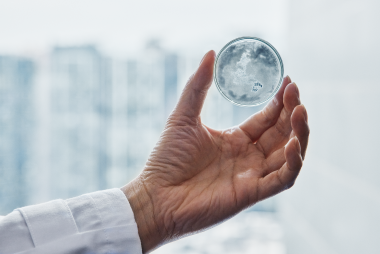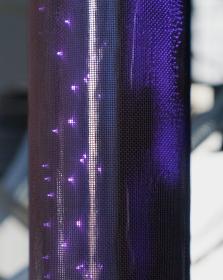Soundwaves to separate microplastics from wastewater
The technology developed by The Hong Kong Research Institute of Textiles and Apparel (HKRITA) with the support of H&M Foundation, can separate microplastics from wastewater using soundwaves. Acousweep is a plug-and-play application. The technology can be easily transported and connected to any wastewater facility. If the technology is implemented at an industrial scale, it will have a significant impact on the fashion industry’s sustainable footprint.
Microplastic pollution is a globally established problem and a threat to ecosystems, animals, and people. Microplastics come from a variety of sources, including from larger plastic debris that degrades into smaller and smaller pieces, or microbeads in exfoliating health and beauty products, or cleansers such as toothpaste. According to the European Environment Agency the major source of oceanic microplastic pollution, about 16%-35% globally, comes from synthetic textiles. Professor Christine Loh, Chief Development Strategist at the Institute for the Environment, The Hong Kong University of Science and Technology, agrees that this technology has great potential.
Microplastics typically refers to tiny plastic pieces or particles smaller than 5mm in diameter according to the definition of United Nations Environment Programme (UNEP) and the European Union (EU). The new technology can separate microplastic fibre longer than 20 μm, which is 250 times smaller than the typical size. Unlike existing filtration processes, the system enables continuous water treatment and easy collection of microplastic fibres by virtue of its acoustic manipulation technique.
Acousweep utilises sweeping acoustic waves in a specially shaped chamber to physically trap and separate microplastic fibres from wastewater effectively. The whole process is merely a physical collection and separation. No chemical, solvent or biological additives are needed. The separated microplastics drip into a collection tank for further treatment, such as recycling. Acousweep, with a developing lab-scale treatment system of the capacity of 100L of water per hour, can be upscaled in industrial plants. The system can be installed in a container with a processing capacity up to 5-10T per hour. The containerised system can be easily transported and connected to the existing sewage outlets of the wastewater treatment system.
Process of Microplastic Fibre Separation:
- At one end of the chamber is a transducer that generates a sweeping acoustic wave at ultrasound frequencies. At the other end, there is a reflector, inside which sweeping acoustic waves are reflected and forms standing waves.
- When standing waves are applied to the particles in a fluid, an acoustic radiation force traps the particles.
- The standing waves then transfer the trapped particles to the reflector side; after that, particles concentrate at the apex of the reflector.
- At the apex is a needle valve which is controlled by a sensory system that monitors the concentration of microplastic fibres there. When the concentration is sufficiently high, the sensory system opens the needle valve to let the microplastic fibres drip into a collection tank.
- A high temperature can be applied to the collection tank to remove the water, leaving the fibres to agglomerate and form a large mass that can be easily dealt with in future treatment.
Green tech has just taken a leap forward in Hong Kong. Acousweep will help the garment and other industries to stop a highly damaging form of pollution. HKRITA used a new technique to remove the microplastics by using soundwave-based system, preventing them from getting into the sea and being ingested by sea life that can even be ingested by humans along the food chain. Acousweep has the capacity to revolutionize industry, says Professor Christine Loh, Chief Development Strategist at the Institute for the Environment, The Hong Kong University of Science and Technology.
wastewater treatment technologies textile waste industrial wastewater treatment plastic waste microplastic
The Hong Kong Research Institute of Textiles and Apparel (HKRITA); H & M Foundation



